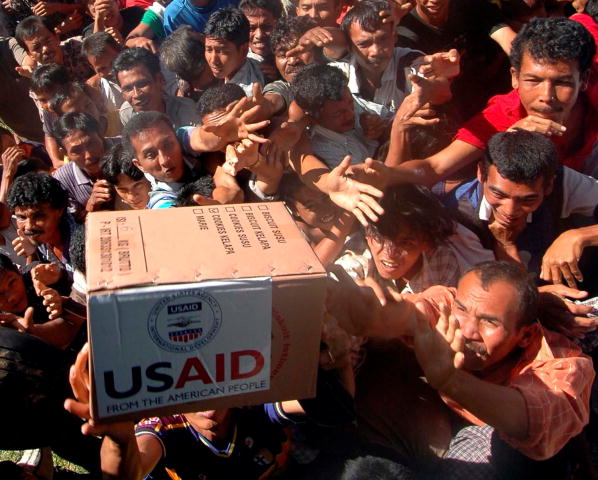Can Food Aids solve Hunger crises ?
Or is Free Trade the solution? What about the green Revolution ??
But these "myths" are leading to social, economical instabilities problems in the world we live in. The drought hitting the horn of Africa is not merely a natural uncontrollable force , it has lead to famine , man's very own act .
2.4 million people in five countries across the horn of Africa are affected, and Tens of thousands of people have already died from starvation, half of whom are children – and malnutrition rates in some regions are worse than anything previously recorded.
World Food Program through its millenium goals aims to end povertyby 2015. NGO's , local or international, are all collaborating to mitigate this crisis. As well, on the field volutneers , online volunteers, journalists , bloggers are all working worldwide together too.But more efforts are needed. And to have more efforts, we need more awareness. This post is nothing but to raise awareness about the general public views towards hunger, the responsible people behind its cause and the authorities actively participating in eliminating it.
Based on the book World Hunger: Twelve Myths and below notes is taken from ( summarized) : Food First, Institute for Food and Development Policy.
Myth 1: Not Enough Food to Go Around
 |
| tree hugger.com |
Abundance, not scarcity, best describes the world's food supply. Enough wheat, rice and other grains are produced to provide every human being with 3,200 calories a day. That doesn't even count many other commonly eaten foods - vegetables, beans, nuts, root crops, fruits, grass-fed meats, and fish. Enough food is available to provide at least 4.3 pounds of food per person a day worldwide: two and half pounds of grain, beans and nuts, about a pound of fruits and vegetables, and nearly another pound of meat, milk and eggs - enough to make most people fat! The problem is that many people are too poor to buy readily available food. Even most "hungry countries" have enough food for all their people right now. Many are net exporters of food and other agricultural products.
Reality: It's too easy to blame nature. Human-made forces are making people increasingly vulnerable to nature's vagaries. Food is always available for those who can afford it - starvation during hard times hits only the poorest. Millions live on the brink of disaster in South Asia, Africa and elsewhere, because they are deprived of land by a powerful few, trapped in the unremitting grip of debt, or miserably paid. Natural events rarely explain deaths; they are simply the final push over the brink. Human institutions and policies determine who eats and who starves during hard times. Likewise, in America many homeless die from the cold every winter, yet ultimate responsibility doesn't lie with the weather. The real culprits are an economy that fails to offer everyone opportunities, and a society that places economic efficiency over compassion.
Myth 3 Too Many People
 Reality: Birth rates are falling rapidly worldwide as remaining regions of the Third World begin the demographic transition - when birth rates drop in response to an earlier decline in death rates. Although rapid population growth remains a serious concern in many countries, nowhere does population density explain hunger. For every Bangladesh, a densely populated and hungry country, we find a Nigeria, Brazil or Bolivia, where abundant food resources coexist with hunger. Or we find a country like the Netherlands, where very little land per person has not prevented it from eliminating hunger and becoming a net exporter of food. Rapid population growth is not the root cause of hunger. Like hunger itself, it results from underlying inequities that deprive people, especially poor women, of economic opportunity and security. Rapid population growth and hunger are endemic to societies where land ownership, jobs, education, health care, and old age security are beyond the reach of most people. Those Third World societies with dramatically successful early and rapid reductions of population growth rates - China, Sri Lanka, Colombia, Cuba and the Indian state of Kerala - prove that the lives of the poor, especially poor women, must improve before they can choose to have fewer children.
Reality: Birth rates are falling rapidly worldwide as remaining regions of the Third World begin the demographic transition - when birth rates drop in response to an earlier decline in death rates. Although rapid population growth remains a serious concern in many countries, nowhere does population density explain hunger. For every Bangladesh, a densely populated and hungry country, we find a Nigeria, Brazil or Bolivia, where abundant food resources coexist with hunger. Or we find a country like the Netherlands, where very little land per person has not prevented it from eliminating hunger and becoming a net exporter of food. Rapid population growth is not the root cause of hunger. Like hunger itself, it results from underlying inequities that deprive people, especially poor women, of economic opportunity and security. Rapid population growth and hunger are endemic to societies where land ownership, jobs, education, health care, and old age security are beyond the reach of most people. Those Third World societies with dramatically successful early and rapid reductions of population growth rates - China, Sri Lanka, Colombia, Cuba and the Indian state of Kerala - prove that the lives of the poor, especially poor women, must improve before they can choose to have fewer children.
Myth 4: The Environment vs. More Food?
 |
| www.bayer.com |
Alternatives exist now and many more are possible. The success of organic farmers in the U.S. gives a glimpse of the possibilities. Cuba's success in overcoming a food crisis through self-reliance and sustainable, virtually pesticide-free agriculture is another good example. Indeed, environmentally sound agricultural alternatives can be more productive than environmentally destructive ones.
Myth 5: The Green Revolution is the Answer
Reality:: The production advances of the Green Revolution are no myth. Thanks to the new seeds, millions of tons more grain a year are being harvested. But focusing narrowly on increasing production cannot alleviate hunger because it fails to alter the tightly concentrated distribution of economic power that determines who can buy the additional food. That's why in several of the biggest Green Revolution successes - India, Mexico, and the Philippines - grain production and in some cases, exports, have climbed, while hunger has persisted and the long-term productive capacity of the soil is degraded. Now we must fight the prospect of a ‘New Green Revolution' based on biotechnology, which threatens to further accentuate inequality.
Myth 6:The Free Market Can End Hunger
So all those who believe in the usefulnes of the market and the necessity of ending hunger must concentrate on promoting not the market, but the consumers! In this task, government has a vital role to play in countering the tendency toward economic concentration, through genuine tax, credit, and land reforms to disperse buying power toward the poor. Recent trends toward privatization and de-regulation are most definitely not the answer
Reality: Unfortunately, such a "market-is-good, government-is-bad" formula can never help address the causes of hunger. Such a dogmatic stance misleads us that a society can opt for one or the other, when in fact every economy on earth combines the market and government in allocating resources and distributing goods. The market's marvelous efficiencies can only work to eliminate hunger, however, when purchasing power is widely dispersed.
 |
| www.toonpool.com |
Myth 7: Free Trade is the Answer
Reality: The trade promotion formula has proven an abject failure at alleviating hunger. In most Third World countries exports have boomed while hunger has continued unabated or actually worsened. While soybean exports boomed in Brazil - to feed Japanese and European livestock - hunger spread from one-third to two-thirds of the population. Where the majority of people have been made too poor to buy the food grown on their own country's soil, those who control productive resources will, not surprisingly, orient their production to more lucrative markets abroad. Export crop production squeezes out basic food production. So-called free trade treaties like NAFTA and WTO pit working people in different countries against each other in a ‘race to the bottom,' where the basis of competition is who will work for less, without adequate health coverage or minimum environmental standards. Mexico and the U.S. are a case in point: since NAFTA we have had a net loss of over a million jobs here in the U.S., while Mexico has lost 1.3 million in the agricultural sector alone and hunger is on the rise in both countries.
Myth 9: Too Hungry to Fight for Their Rights
Reality: Bombarded with images of poor people as weak and hungry, we lose sight of the obvious: for those with few resources, mere survival requires tremendous effort. If the poor were truly passive, few of them could even survive. Around the world, from the Zapatistas in Chiapas, Mexico to the Landless People's Movement in South Africa, wherever people are suffering needlessly movements for change are underway. People will feed themselves, if allowed to do so. It's not our job to ‘set things right' for others. Our responsibility is to remove the obstacles in their paths, obstacles often created by large corporations and U.S. government, World Bank and IMF policies.
Myth 10: More U.S. Aid Will Help the Hungry
 Reality: Most U.S. aid works directly against the hungry. Foreign aid can only reinforce, not change, the status quo. Where governments answer only to elites, our aid not only fails to reach hungry people, it shores up the very forces working against them. Our aid is used to impose free trade and free market policies, to promote exports at the expense of food production, and to provide the arms that repressive governments use to stay in power. Even emergency, or humanitarian aid, which makes up only eight percent of the total, often ends up enriching American grain companies while failing to reach the hungry, and it can dangerously undercut local food production in the recipient country. It would be better to use our foreign aid budget for unconditional debt relief, as it is the foreign debt burden that forces most Third World countries to cut back on basic health, education and anti-poverty programs.
Reality: Most U.S. aid works directly against the hungry. Foreign aid can only reinforce, not change, the status quo. Where governments answer only to elites, our aid not only fails to reach hungry people, it shores up the very forces working against them. Our aid is used to impose free trade and free market policies, to promote exports at the expense of food production, and to provide the arms that repressive governments use to stay in power. Even emergency, or humanitarian aid, which makes up only eight percent of the total, often ends up enriching American grain companies while failing to reach the hungry, and it can dangerously undercut local food production in the recipient country. It would be better to use our foreign aid budget for unconditional debt relief, as it is the foreign debt burden that forces most Third World countries to cut back on basic health, education and anti-poverty programs.
More Interesting Reads :
World Hunger Series: Hunger and Markets : http://home.wfp.org/stellent/groups/public/documents/communications/wfp200279.pdf
Food Zoning , a Strategy to Fight Food Insecurity
//www.menafn.com/qn_news_story.asp?storyid={29799dc6-f469-4582-a2a2-4239391dc126}
Campaigns to End Hunger:
One Campaign: http://www.one.org/international/blog/drought-might-be-inevitable-but-famine-is-not/
The G20 response to the food crisis of 2011 needs better politics and greater ambition
http://www.simonmaxwell.eu/blog/the-g20-response-to-the-food-crisis-of-2011-needs-better-politics-and-greater-ambition.htmlWorld Hunger Series: Hunger and Markets : http://home.wfp.org/stellent/groups/public/documents/communications/wfp200279.pdf
Food Zoning , a Strategy to Fight Food Insecurity
//www.menafn.com/qn_news_story.asp?storyid={29799dc6-f469-4582-a2a2-4239391dc126}
Campaigns to End Hunger:
One Campaign: http://www.one.org/international/blog/drought-might-be-inevitable-but-famine-is-not/
Unicef : http://www.supportunicef.org/site/pp.asp?c=9fLEJSOALpE&b=7542627
FAO : http://www.fao.org/crisis/horn-africa/home/en/
WFP: World Food Program : http://www.wfp.org/crisis-horn-africa ,
WFP Donation : https://secure.my-websites.org/supporter/donatenow.do?n=gbss&dfdbid=1075640
FAO : http://www.fao.org/crisis/horn-africa/home/en/
WFP: World Food Program : http://www.wfp.org/crisis-horn-africa ,
WFP Donation : https://secure.my-websites.org/supporter/donatenow.do?n=gbss&dfdbid=1075640



No comments:
Post a Comment